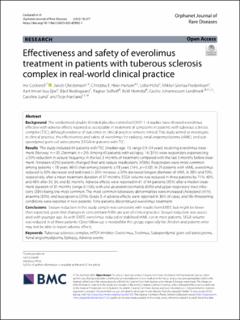| dc.description.abstract | Background The randomised double‑blinded placebo‑controlled EXIST‑1–3 studies have showed everolimus
effective with adverse effects reported as acceptable in treatment of symptoms in patients with tuberous sclerosis
complex (TSC), although evidence of outcomes in clinical practice remains limited. This study aimed to investigate,
in clinical practice, the effectiveness and safety of everolimus for epilepsy, renal angiomyolipoma (rAML), and sub‑
ependymal giant cell astrocytoma (SEGA) in patients with TSC.
Results The study included 64 patients with TSC (median age: 19, range 0.9–54 years) receiving everolimus treat‑
ment (Norway: n = 35; Denmark: n = 29). Among 45 patients with epilepsy, 14 (31%) were responders experiencing
≥ 50% reduction in seizure frequency in the last 3 months of treatment compared with the last 3 months before treat‑
ment. Nineteen (42%) patients changed their anti‑seizure medications (ASMs). Responders were more common
among patients < 18 years (46%) than among patients ≥ 18 years (14%, p = 0.03). In 29 patients with rAML, everolimus
reduced (≥ 30% decrease) and stabilized (< 20% increase, ≤ 30% decrease) longest diameter of rAML in 38% and 59%,
respectively, after a mean treatment duration of 37 months. SEGA volume was reduced in three patients by 71%, 43%,
and 48% after 39, 34, and 82 months. Adverse effects were reported in 61 of 64 patients (95%) after a median treat‑
ment duration of 31 months (range 0–106), with oral ulceration/stomatitis (63%) and upper respiratory tract infec‑
tions (38%) being the most common. The most common laboratory abnormalities were increased cholesterol (41%),
anaemia (30%), and leucopoenia (25%). Grade 3–4 adverse effects were reported in 36% of cases, and life‑threatening
conditions were reported in two patients. Nine patients discontinued everolimus treatment.
Conclusions Seizure reduction in this study sample was consistent with results from EXIST, but might be lower
than expected, given that changes in concomitant ASMs are part of clinical practice. Seizure reduction was associ‑
ated with younger age. As with EXIST, everolimus reduced or stabilised rAML size in most patients. SEGA volume
was reduced in all three patients. Close follow‑up is needed for this group, especially for children and patients who
may not be able to report adverse effects. | en_US |

